Elizabeth Minchilli's Blog, page 15
February 6, 2019
marigold {rome}
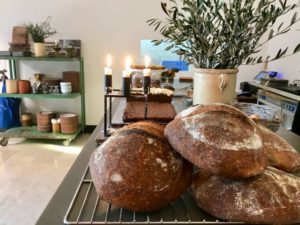
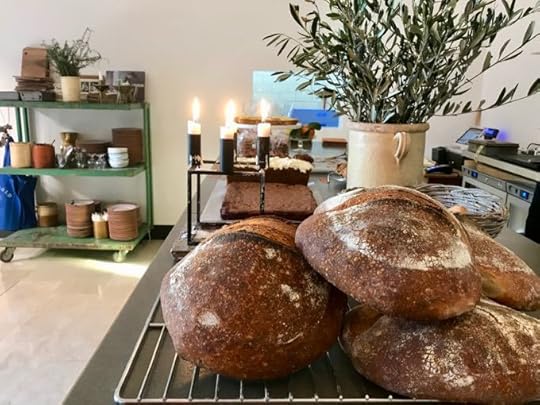
One of my favorite ‘new’ restaurants in Rome is Marigold. I’m using the quotation marks because while it is recently opened (only since December) the owners are already well known on the Rome restaurant scene.
If you’re a longtime reader of this blog then you probably will recognize Sofie and Domenico (no, not my Sophie and Domenico) from this past post about their pop up restaurant The Eatery. They ran this super cool supper club out of their tiny kitchen for the last 5 years. Once a month 10 lucky guests would get the chance to enjoy Domenico’s seasonal, local and creatively prepared food along with Sofie’s famous bread and desserts.
They also catered in private homes and one of their delicious 5 course meals is featured in my new book, The Italian Table.
For years they dreamed of opening their own restaurant. After looking for the perfect space they have finally landed in the up and coming neighborhood of Ostiense. Just past the Piramide and a few steps away from trendy Testaccio, the restaurant is a bright, open and airy space that reflects Domenico’s Italian warmth and Sofie’s Danish sense of style.
Now comes the difficult part of choosing what to write about. I’ve only eaten there three times (so far!) but I so deeply want to share every photo and bite I put in my mouth. I’ve been there for breakfast, lunch and dinner so I’ve pretty much roamed all over the menu.
I guess the first thing I have to emphasize are the things that make Marigold different. They do breakfast. And brunch. And when I say this I mean it in the true American or even Australian sense of the word. Not the Italian version of a lunch buffet on Sundays, but early morning coffee, home made pastries and things most of us ex-pats only dream about like eggs Benedict, pancakes and porridge. Avocado toast is there too, all day long.
Also, the bread. Not only do I give you full permission to fill up before your meal on Sofie’s sourdough bread served with danish butter, I consider this one of the major reasons for going there. Although in most Italian restaurants bread is meant to be eaten with your meal, here it’s just too good to play a secondary role. Also? The crusty loaves are for sale to take home with you. (My freezer is currently full).
And finally, but mostly, the food. Domenico spent several years working at the American Academy of Rome’s Sustainable Food Project, which was begun by Alice Waters. And his approach to cooking, which pairs healthy, local and sometimes even foraged ingredients, shines through in dishes like Roasted Cauliflower with Beets and Citrus and Pork Confit topped with Puntarelle. I especially loved the Bacala’ with Cicercie I had for lunch a few weeks ago. At the moment they haven’t added pasta to the menu, but since this is Domenico’s speciality, I’m sure it’s coming soon.
Last but not least, make sure you come with a shopping bag. In addition to a loaf of the sourdough bread, you’re probably going to want to take home a half dozen of Sofie’s Cinnamon Rolls, a bag of her Spiced Almond Cookies and various other baked goods which change daily.
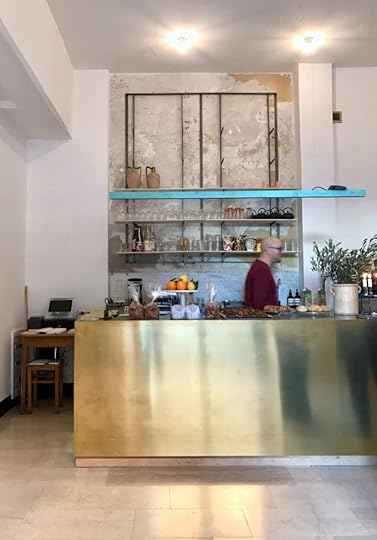
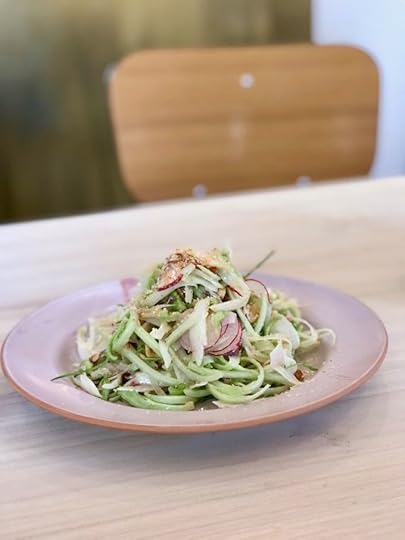
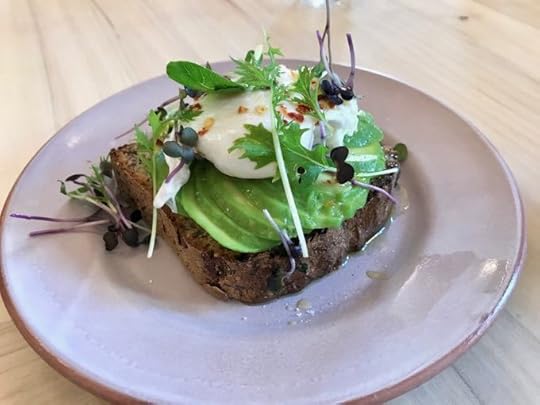

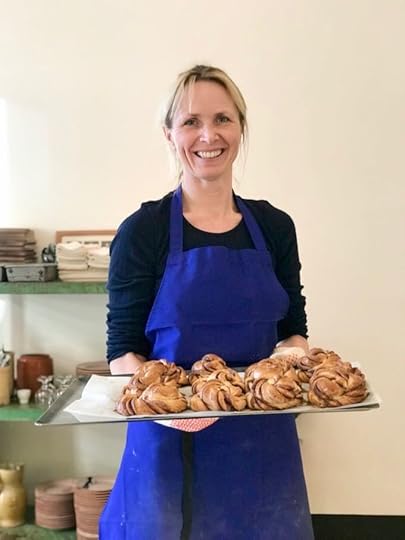

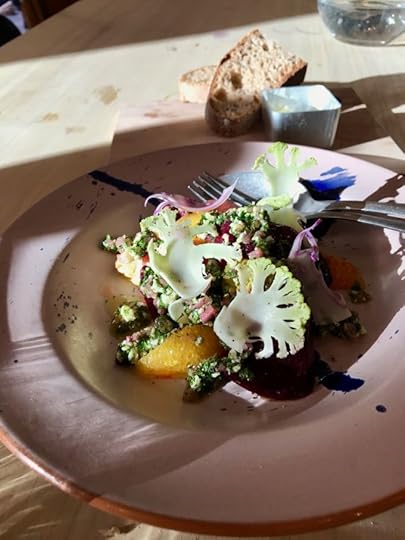
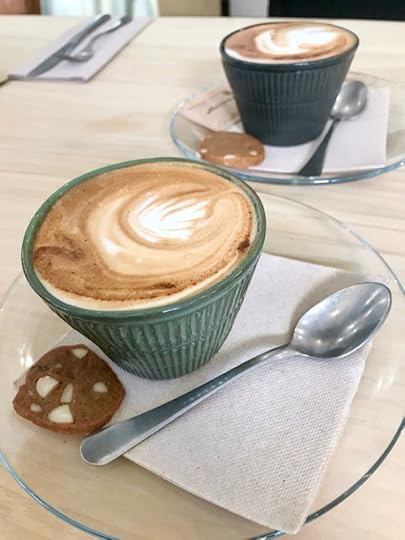
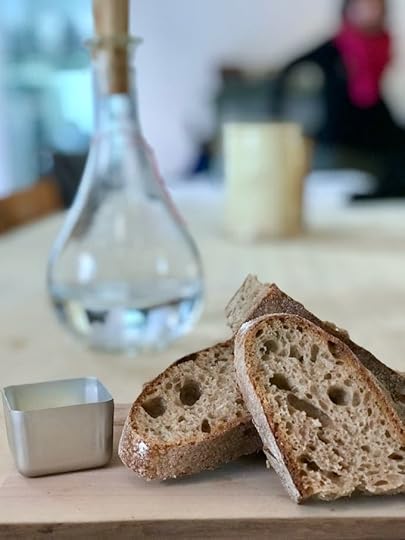

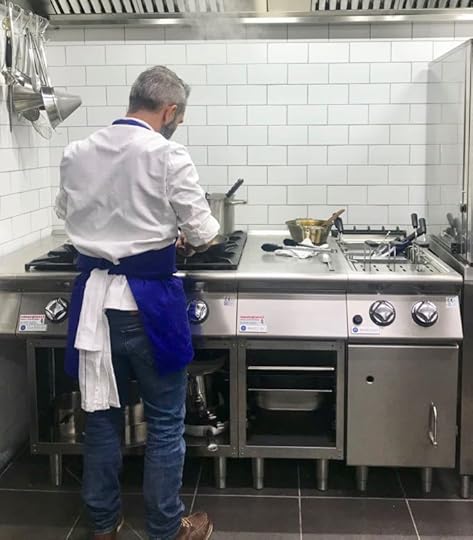
Marigold
Via Giovanni da Empoli 37
00154 Roma
Tel: 39.06.877.25679
Tuesday – Thursday 8am-5pm
Friday 8am-11pm
Saturday 9am-11pm
Sunday 9am – 5pm
Closed Monday
For more on Restaurants in Rome and elsewhere download my app Eat Italy.
Eating Rome is my memoir and guide for eating your way around the city, with recipes and more.
And if you’d like to cook up an entire menu based on Marigold’s recipes order my new book: The Italian Table.
The post marigold {rome} appeared first on Elizabeth Minchilli.


January 17, 2019
New York Times Travel Show with Melissa Clark


Sophie and I are heading to New York next week, to the New York Times Travel Show. I’ve never been before, so I’m hugely excited! It’s the biggest travel show of its kind, with about 600 booths from all over the world. It’s a place to be inspired, find out more about destinations you’ve only dreamed about, and meet and listen to experts talk about their experiences and give advice.
The main reason that I’m going this year is because I’ve been invited to give a few talks. On Sunday January 27, Melissa Clark and I will be on the Taste of the World stage chatting about a subject that we feel very strongly about. Melissa and I have been traveling together for the last 20 years or so, and one of the many things we’ve discovered is that when you follow your appetite, it will not only lead you to delicious places, but you’re also more likely to have an experience that will send you off the beaten track, while supporting local economies in a truly sustainable way.
When: Sunday, January 27, 1:00
Where: New York Times Travel Show
Jacob Javits Center
Taste of the World Stage
What: Melissa and I will be talking about why culinary tourism is not only sustainable, but will take you away from the crowds. During our talk, tastings of olives, artichokes, nougat and panettone will be provided by Gustiamo and FoodMatch/Divina.
We will also be signing books afterwards: I will be signing copies of Eating Rome and Eating Your Way Through Italy and Melissa will be signing copies of Dinner: Changing the Game.
How: Here is link to buy a ticket to the entire show. A day pass is $20, and in addition to being able to attend our talk, there’s lots more going on all day.
SPECIAL NOTE: If you are a travel professional and are attending Friday’s sessions (open only to trade) I’ll be participating in two talks that day:
Friday January 25
11:15, Room 1E10: Unique Culinary Experiences Around Europe
4:15: Room 1E14: Focus on Culinary Tourism
Hope to see you in New York!!!!
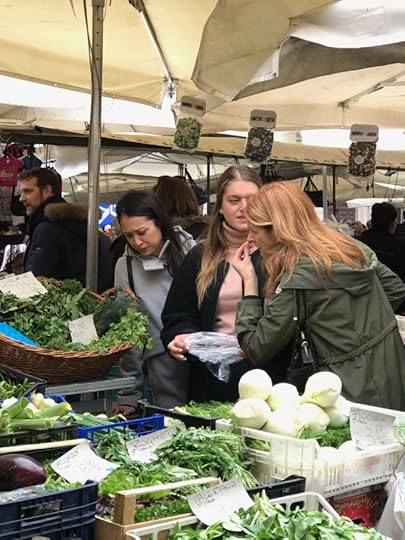
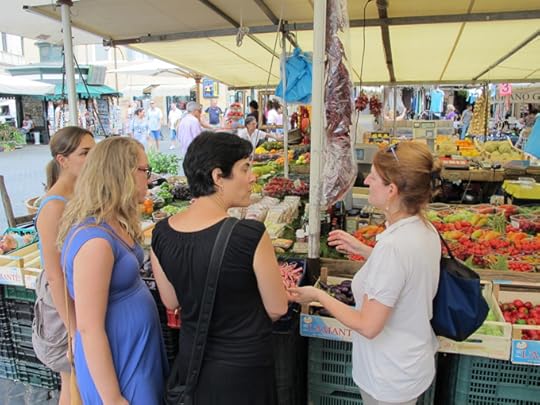
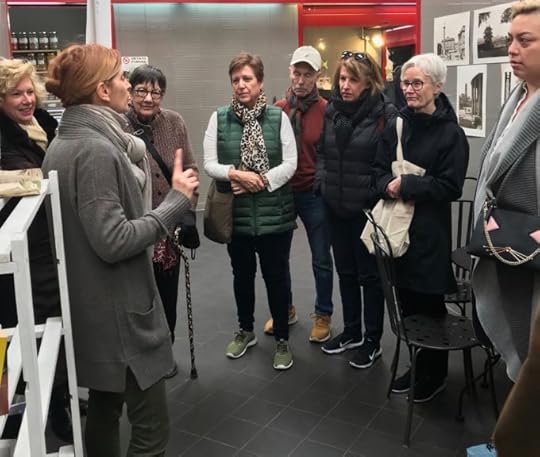
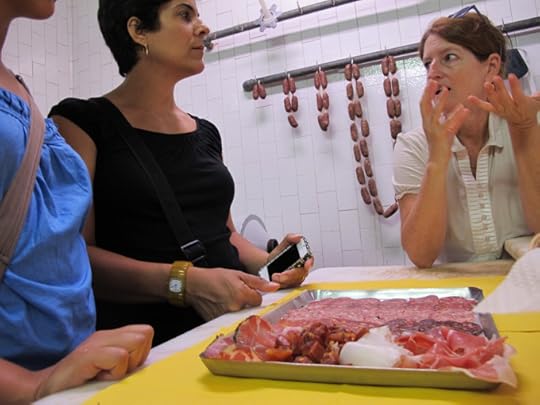
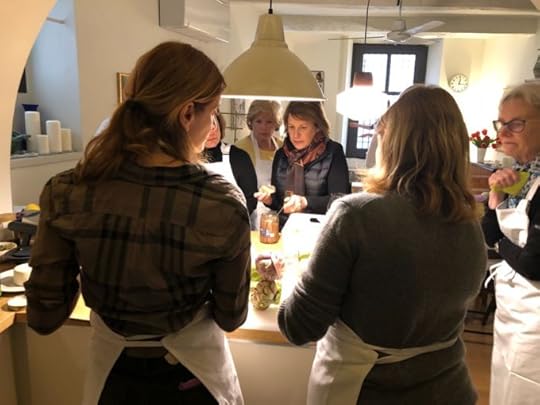
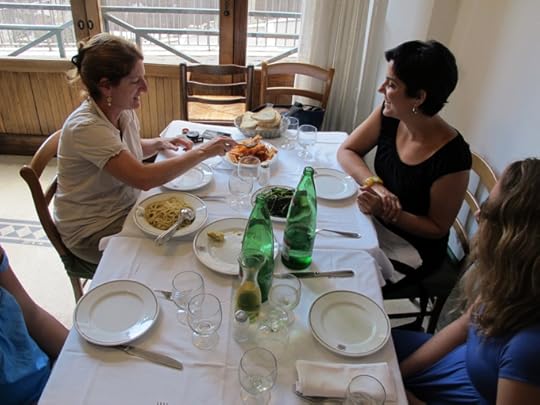
If you’d like to find out more about my Week in Italy Tours visit this page for the schedule. There are still a few spots left for our Nose to Tail Cooking with Melissa Clark March 3-9, 2019.
The post New York Times Travel Show with Melissa Clark appeared first on Elizabeth Minchilli.


January 15, 2019
chestnut pavlova {dinner party menu}

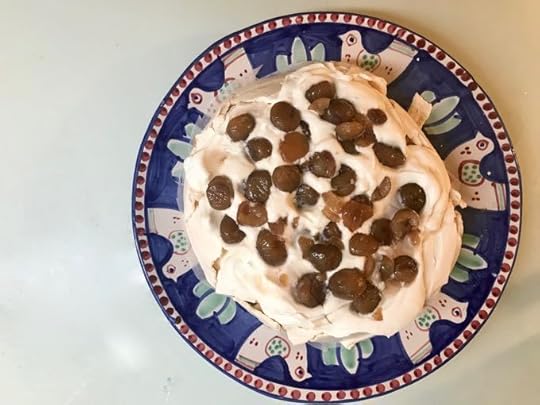
If the picture of the pavlova above leaves a bit to be desired I can only blame it on the vodka. Or champagne. Or wine. Or all of the above because it was taken at about 11:45 on New Year’s Eve. But so great was this dessert – and the rest of the dinner actually – that I really wanted to share it. Good photos or not.
It might be odd sharing a New Year’s Eve menu about a year before you need it. But really? This menu is a good stand in for any kind of fancy celebration. While it does have certain dishes that are traditionally prepared by Russians on New Year’s Eve I’m not going to tell anyone if you’re not.
As usual we celebrated the New Year at home. What was not so usual is that both daughters, Emma and Sophie, were with us. Emma’s friends came too, and since they are of Russian descent the entire Russian inspired menu just kind of happened.
One dish that is an absolute must for any Russian New Year’s celebration is Salat Olivier, or Russian Salad. Called Insalata Russa in Italian it’s basically various cooked vegetables held together with mayonnaise. There are also pickles and/or meat. Everyone has their own version and as I learned from my friend Eugenia only Hellmanns’ mayonnaise will do, as well as a very specific type of dill pickle you can only get at one store in Rome.
While getting my nails done the week before our dinner the Anna and Oksana (who are Ukrainian) insisted that if Eugenia was preparing and bringing Salat Olivier I had to make something called Shuba. This roughly translates as furry overcoat and is another mayonnaisey salad. But instead of meat there is herring (a plus in my book) and the entire thing is topped with bright red beets (I guess this is the over coat?). Since beets and herring are two of my favorite things, I thought this idea was brilliant.
I can’t tell you how proud I was to bring out this drop dead gorgeous platter as a surprise for our guests. I naturally figured that since they loved the Russian Salad thing this would be a sure winner. As it turns out none of them likes herring or beets. Go figure. I thought it was fantastic! Although I did discover it’s not the lightest of dishes and a little Shuba goes a long way. Which I guess is why it’s made once a year?
Emma’s friend Sasha (who is actually a Cordon bleu trained chef) made two savory pies (one cabbage and one lamb) which were gorgeous.
For dessert I decided to go a bit off of the Russian theme, but not too far. At least Pavlova has a Russian name. Evidently this meringue based dessert was named for the ballerina Anna Pavlova. I always thought it originated in Australia, but some people say New Zealand. In any case I make it all the time , but usually in the summer when it can be piled high with fresh berries. My winter version took it in a completely new direction. I had a huge jar full of chestnuts in syrup from the farmers market and so used them to turn the Pavlova into a type of Monte Bianco (minus the mille feuille crust which I never really liked anyway).
That last picture is for good luck. Literally. At the stroke of midnight all good Italians eat a spoonful of Lentils to bring prosperity for the new year. Also? We each got a lottery ticket and I won 2 Euros! So I guess the lentils do work! (although you can leave it off your menu if it’s not New Years!)
Here is the complete menu from that night:
Antipasti
Brown bread with Sour Cream and Salmon Roe
Sea Bass Tartare with orange zest
Endive with citrus and goat cheese
Main Course
Salat Olivier (there are tons of recipes out there)
Savory Tarts (Sasha used pre bought pastry dough and made one filled with cabbage and one with meat)
Dessert
Chestnut Pavolva (see below for recipe)
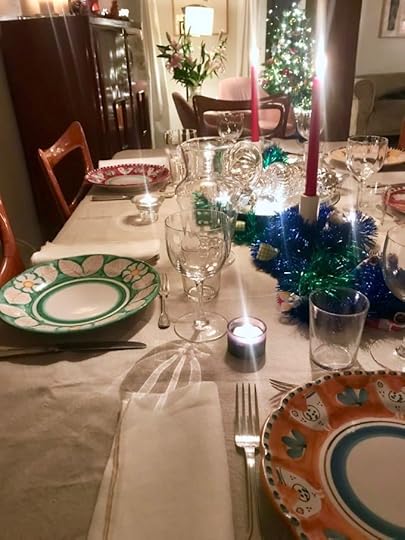
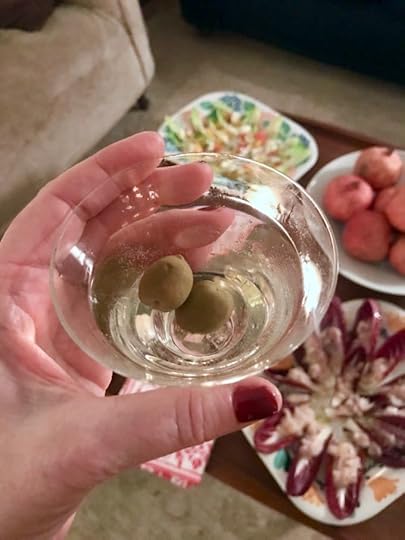
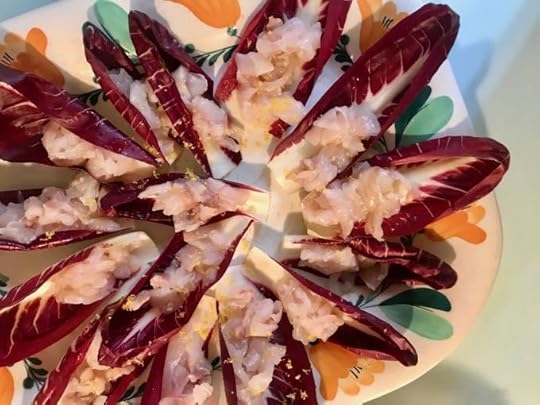

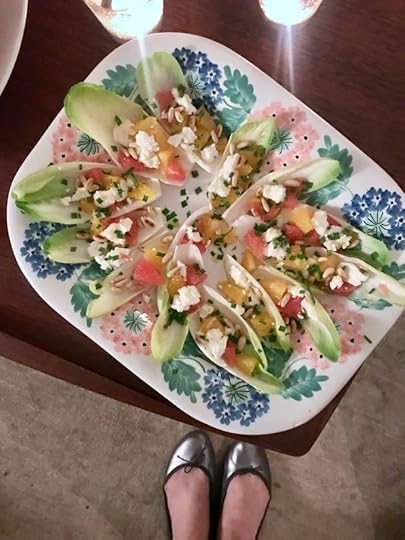
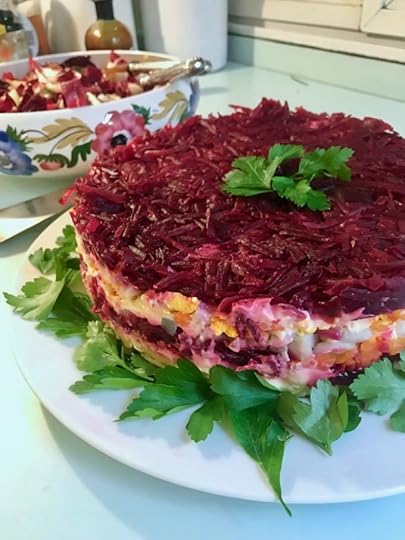
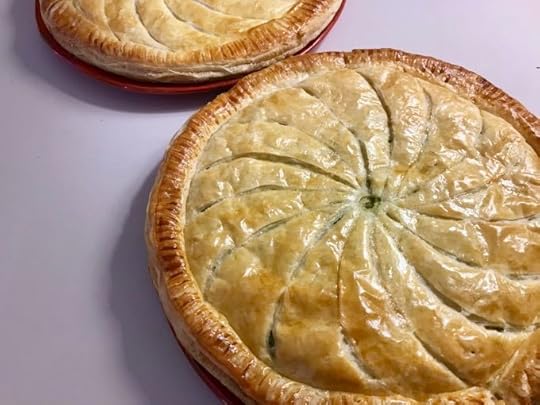
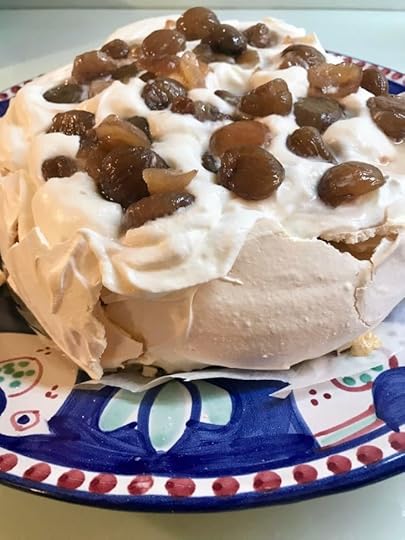
chestnut pavlova
Yield 6-8
I usually make this recipe with berries, but this version, which is almost like the Italian Monte Bianco, may be my new favorite.
Ingredients
4 egg whites
pinch of salt
1 cup sugar
2 tsp cornstarch
2 tsp vanilla extract
1 tsp apple cider vinegar
1 cup heavy cream
2 cups chestnuts in syrup
1 tablespoon of rum
Instructions
Preheat oven to 180F/ 80C
Line a baking sheet with parchment paper of aluminum foil.
Put the egg whites in a bowl and beat on high speed with a hand mixer for about a minute, until stiff. Add the sugar, a bit at a time, with the mixer still on high. Beat until stiff shiny peaks form. This should only take a couple of minutes.
Add the cornstarch and vanilla and fold into egg whites.
Turn out the mixture onto the pan and spread into a rough 9 inch circle.
Bake for 1 and a half hours. Turn the oven off and let cook in the closed oven for 1 hour. The meringue should be crisp on the outside, but soft on the inside.
Whip the heavy cream. I like mine without sugar, but feel free to add some if you’d like.
Gently peel off the paper from the meringue, and gently place on a plate.
Place 1 1/2 cup of the chestnuts into a food processor along with 2 tablespoons of the syrup they were packed in and the rum. Blend until very smooth.
Assemble at the very last minute:
Right before serving pat down the center of the meringue to form a bit of a dent. Gently spread the chestnut puree on the top. It will be crumbly and difficult but don’t worry, you will cover it with the whipped cream
Spread the whipped cream on top, then gently scatter the remaining chestnuts on top. If they are whole, you might want to cut them into smaller pieces first.
It’s kind of a mess to serve. But a delicious mess.
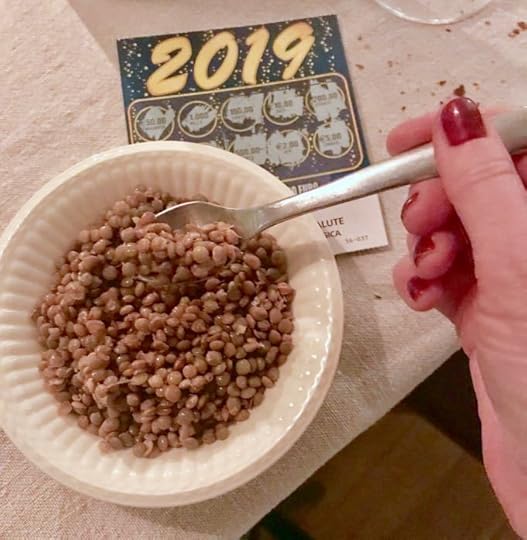
For more menus and ideas for planning your own Italian party order my new book The Italian Table: Creating Festive Meals for Families and Friends.
The post chestnut pavlova {dinner party menu} appeared first on Elizabeth Minchilli.


January 6, 2019
Creative & Culinary Retreat in Puglia with Elizabeth Gilbert

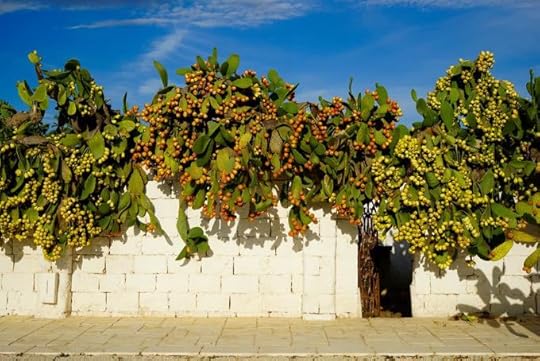
Are you currently huddled up in front of a fire? Are you dreaming of summer already? I know it seems a long way off, but I’ve already made plans. While I usually take time off from organizing tours from June to August, this coming July I’m making an exception. I couldn’t resist the opportunity to offer a one time special tour with my friend Elizabeth Gilbert. I first met Liz when she was researching Eat, Pray Love way back….oh god, how many years ago was it? 12 years ago? I remember reading an advance copy of the book and thinking “I think this will be popular.” Hah! Zillions of copies later….Is there anyone who hasn’t read or heard of it? Anyway, a lot has happened since then, and Liz has gone on to write many more books, including Big Magic, which details her creative process.
A few months ago Liz was back in Rome and we met up after way too long. Over cappuccini on the Tiber Island we decided it would be fun to do something together. And so we basically decided if we could go anywhere in Italy in July, where would it be? And what would we do? And so we came up with this trip. Would you like to join us?
During our 5 day retreat you’ll have the chance to work directly with Liz, during a workshop which explores creativity. And then have the chance to be inspired yourself, as you join Sophie and me to explore one of the most beautiful – and delicious – corners of Italy: Puglia. We will be based in two of my favorite hotels in Italy, one in Puglia and the other in Matera, in Basilicata.
Details:
When: July 8 – 13, 2019
Who: Space is limited. There will be a maximum of 20 guests.
Where: We’ll be based in two fabulous hotels, one in Puglia, near Manduria and the other in the town of Matera in Basilicata.
What: Our days will be full, but there will also be plenty of time to relax.
Some of the things we’ll be doing:
Welcome feast of organic, local foods
Full day Big Magic Workshop with Elizabeth Gilbert
Cooking Class with Maria Grazia
Twilight Feast and dancing to local music
Visit to a ceramic artisan
Seaside Lunch
Cheese making lesson…and much more!
I hope you can join Liz, Sophie and me for this delicious and inspirational retreat. Would you like more information? Just send me an email.
(since the request for this tour is very high, it may take me a week to get back to you. I will be keeping track of the order of requests I receive. Thank you for your patience).

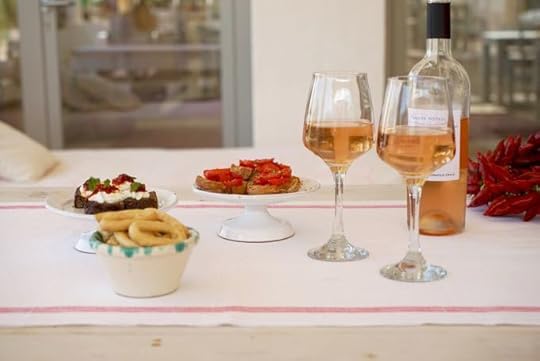
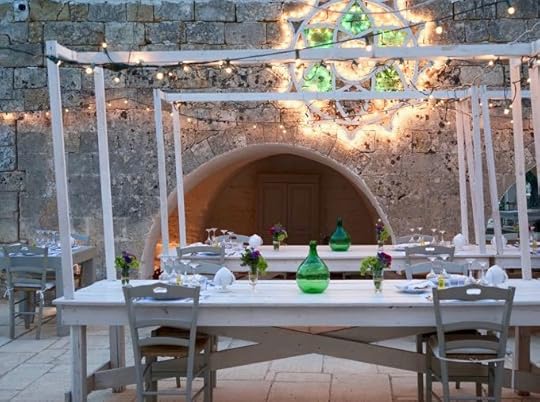
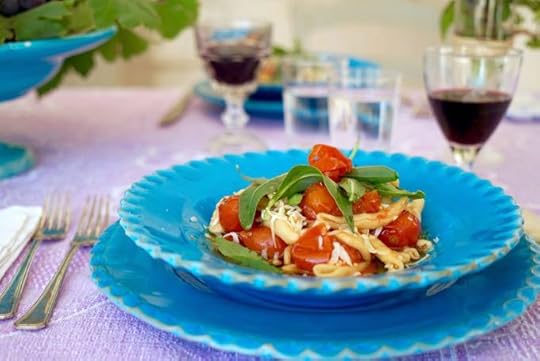
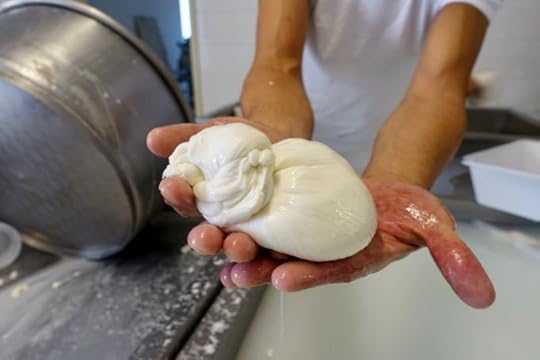
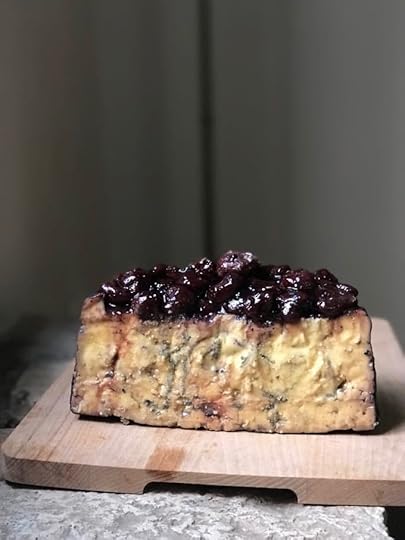
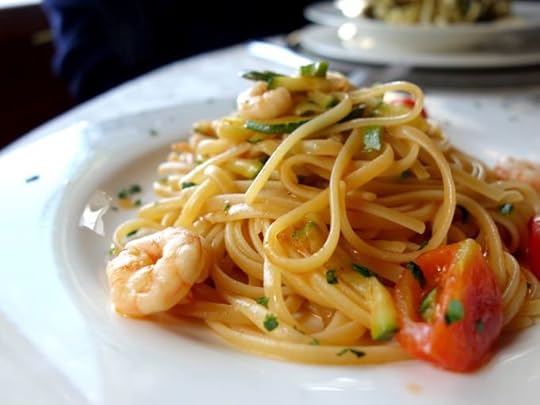
For more information about A Creative and Culinary Retreat in Puglia with Elizabeth Gilbert and Elizabeth Minchilli please send an email to elizabeth (at) elizabethminchilli (dot) com
If you’d like to find out about our other tours in Rome, Umbria and Puglia see our entire schedule for 2019 and 2020 here.
And if you’re coming to Rome for the day, and would like to do a market tour just contact Sophie
The post Creative & Culinary Retreat in Puglia with Elizabeth Gilbert appeared first on Elizabeth Minchilli.


December 18, 2018
italian brunch ideas
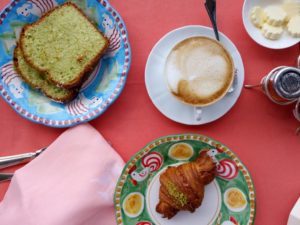
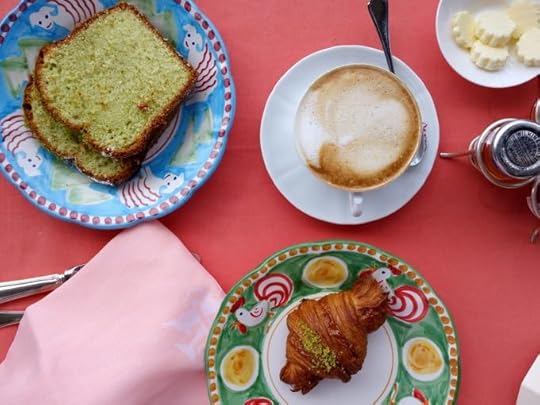
Italians, in general, are pretty strict when it comes to meal times. There is Breakfast, Lunch and Dinner and very little snacking in between (Gelato being a very important exception). That said, the rigid hours that restaurants usually keep have changed slightly in the last 10 years or so. Not only have the ever increasing amounts of tourists in most major cities forced restaurant owners to re-think and extend the whole idea of ‘meal time’, but even Italians are enjoying a bit more leeway when it comes to dining.
One of the newish ‘meals’ in Italy is aperi-cena, which turns a before dinner drink into more of a real meal, with bar buffets full of enough finger food to see you through the evening. Another meal that has made its way into Italian culture is Brunch. Although I hope when you are reading this you are pronouncing it the Italian way, with a long rolling ‘r’. Brrrrrrunch.
While more and more restaurants are offering ‘brrrrrunch’, I’ve come to realize that it is a far cry from the breakfast-leaning American brunch. Instead it is a buffet that runs from about noon (early for Italians to eat lunch) until about 3 or so. It’s a very relaxed affair, with a fixed price that makes it attractive for whole families to head out on a Sunday morning. But rarely does it have any true breakfast items. No eggs except for maybe a frittata. You’re more likely to see a pasta or rice salad, as well as tons of cakes.
When I decide to have brunch at our home it’s halfway between the new Italian meal, and American version I grew up with. There are definitely no bagels. (I wish there were, but Italy just hasn’t adopted this yet). Instead, I pick and choose from recipes I make all the time, but that can be breakfasty enough for me, while not completely throwing Italian tradition to the wind.
Although Italians never eat eggs for breakfast, I make sure I include them. While I often just whip on a big frittata, I’m very partial to its lighter version, the Fazoletto. It’s not only prettier, I also like the fact that it has lots of seasonal herbs and vegetables. And if I’m feeling even more adventurous I might work eggs AND bacan (i.e. pancetta) into a spinach salad. That’s brunchy, right?
Since I tend to make brunch in the winter, and since the fruit situation isn’t that great, I jazz up banana, apple and pear filled fruit salad with copious amounts of ginger. Whenever I add ginger to a fruit salad guests tend to forget it’s the healthy part of the meal, and dig in for seconds before completely losing themselves in the cake portion of the meal.
Because there is always cake.
Basically Italians eat cake for breakfast. It’s a thing. And since I am married to an Italian, I always include at least one breakfast cake. Either a classic ciambella or, if I’m feeling fancy, a pistacchio pound cake recipe I picked up in Positano.
So while this menu is in no way classically Italian, it does bring in Italian recipes to a meal that I for one do serve in Italy, and that you can serve anywhere you’d like. And call it anything you want to. Breakfast. Lunch. Or Brrrrrrrunch
Menu
Fazzoletto or Spinach Salad with Pancetta & Eggs
Pistacchio Pound Cake or Ciambella
What to Drink
Coffee of course. This is Italy.
If you are going to all the trouble of making brunch, and inviting guests, you better have something festive (i.e. alcoholic ) to drink. My go to brunch cocktails are:
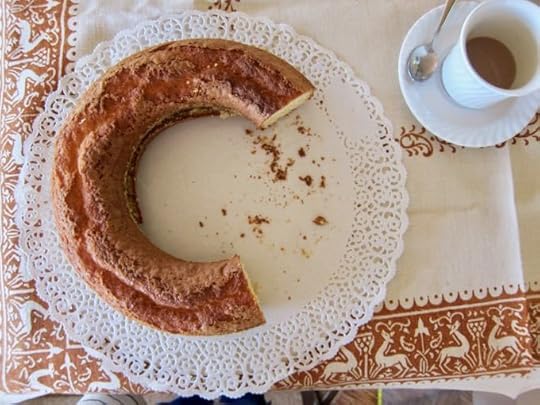
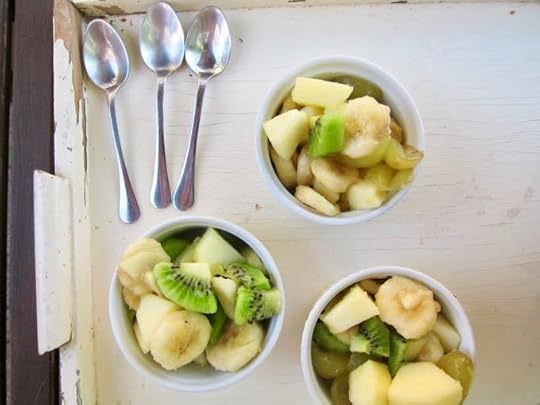
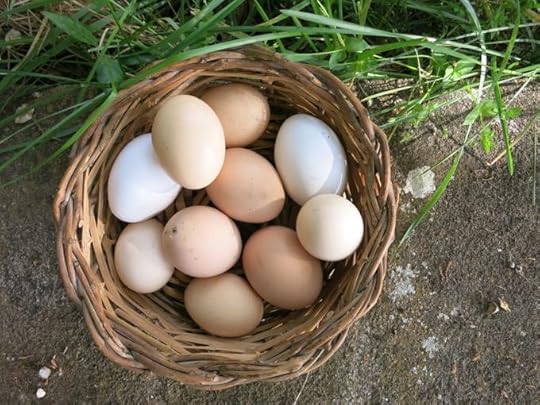
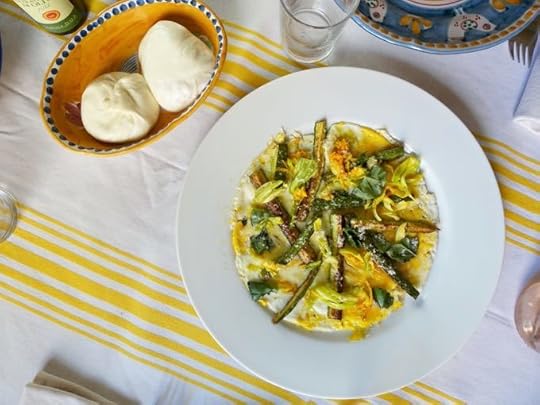

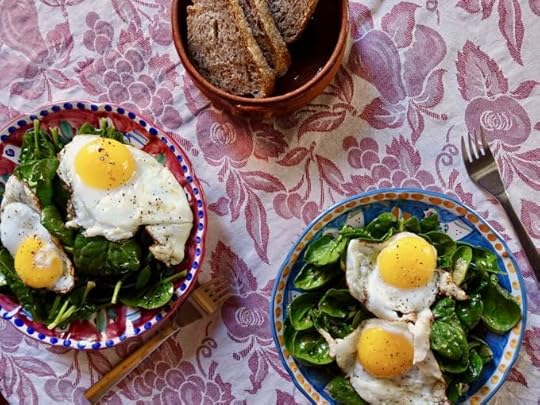
Want more ideas about hosting your own Italian meal at home? Order my new book: The Italian Table: Creating Festive Meals for Family and Friends (Rizzoli March 2019).
Would you like to join me for a week of meals in Italy? Join me and Sophie for a Week in Italy Food Tour to Rome, Umbria or Puglia.
The post italian brunch ideas appeared first on Elizabeth Minchilli.


December 11, 2018
making anolini with silvana {video}
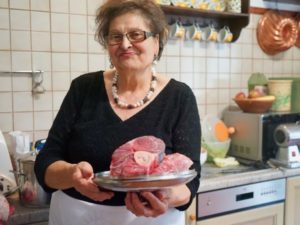
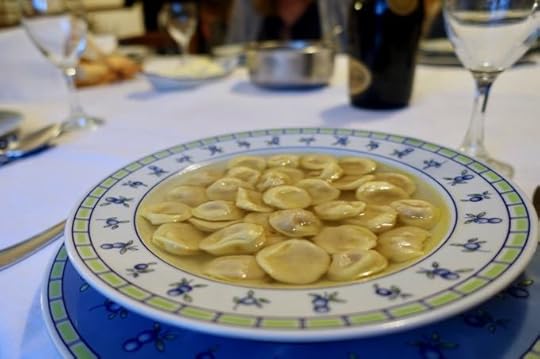
There are a series of towns in Emilia Romagna that all run in a straight line, more or less, along the Autostrada A1 connecting Bologna, Modena, Reggio Emilia and Parma, with Bologna being the biggest in the bunch. Although one is not further than 30 kilometers from the next, I found that when it comes to stuffed pasta, you better know your terms before asking for something.
Maria Chiara, who works at the Consorzio di Parmigiano Reggiano had organized a few visits for me to local rezdore. Loosely translated rezdora means house wife, but what it really means is queen of the kitchen. It is the word that is used to describe the women, usually older, who are keeping alive the traditions of the recipes of Emilia Romagna. And so I was thrilled to be able to visit some of them near Maria Chiara’s home town of Calestano, just south of Parma.
When I first walked into Silvana’s house, everyone was in the kitchen, talking. I spied the pasta she had made earlier that day. laid out carefully on the kitchen table, with a dish cloth covering it. I lifted the edge, and said “Oh! ravioli!” All conversation stopped. Everyone was looking at me. I though, oh no, I should never have touched the cloth. But no, it wasn’t that. While Silvana gave me a look, Maria Chiara explained what had shocked
everyone. “Those aren’t ravioli” she said, “They are anolini.”
Never heard of anolini? Me neither. nor seen them even. This is how specific stuffed pasta can be. I doubt there is even a restaurant in Rome that serves anolini. Or possibly even in Bologna. They are very specific to the region around Parma and involve an even more complicated procedure than tortellini.
Every single ingredient has its reason for being there, and a specific way of preparing it. Not just any bread crumbs, but fresh bread, cut in cubes the day before, then dried out in the oven then turned into crumbs in the food processor but “Not too fine, not too big, but in the middle.” Also? The bread itself was homemade.
And the discussion about which kind of Parmigiano to use went on for ages. In the end Silvana decided to use a mixture of both 32-month-old and 22-month-old. When you see the huge quantity of parmigiano that goes into these little shapes you’ll begin to understand why the quality of this essential ingredient is so important.
One thing that we tend to forget today, is what a special occasion even any of these stuffed pastas were. While watching Silvana make both the stuffing for the anolini, as well as the broth, I realized just how expensive these ingredients must have been in the past. There was a ton of meat involved, both for the filling and the broth, as well as expensive aged Parmigiano. Today, while we are used to stuffed pasta filling up aisles at the supermarket it was both impressive, and daunting, to see the skill and time and effort that went into making these miniature works of culinary art.
Although the term anolini refers to stuffed pasta in general, in the Parma area they are always stuffed with a stuffing of pot roast and parmigiano. And the shape is always round, and always smooth along the edge.
Here is a very long video I shot that day. While I usually try to keep the videos here short and sweet, we spent the ENTIRE day with Silvana as she crafted these little works of wonder. And so this video clocks in at 9 minutes. Which is a pretty condensed version of the 9 hours it actually took to make the anolini.
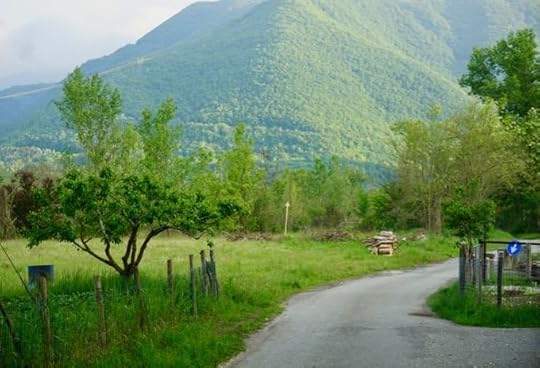
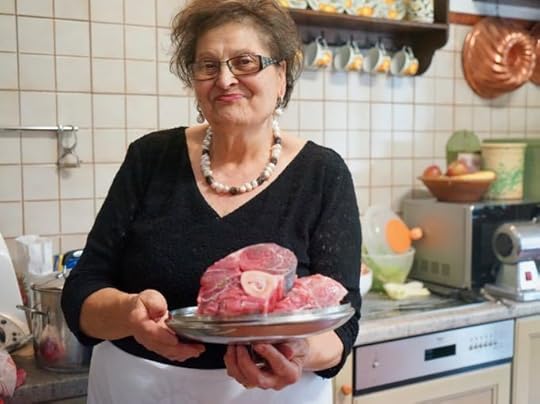
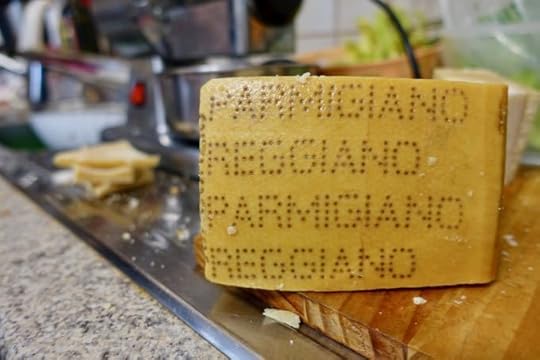
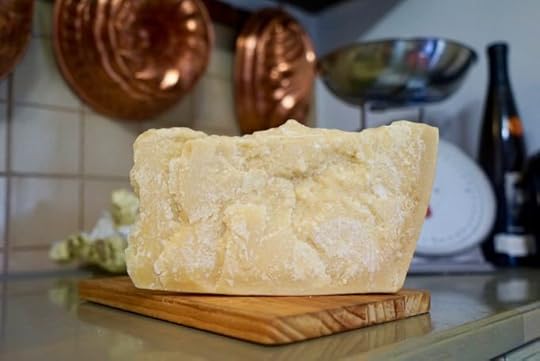
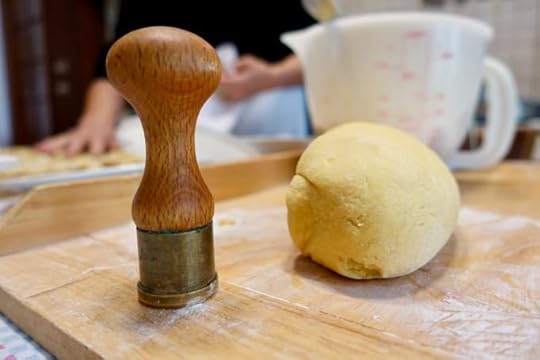
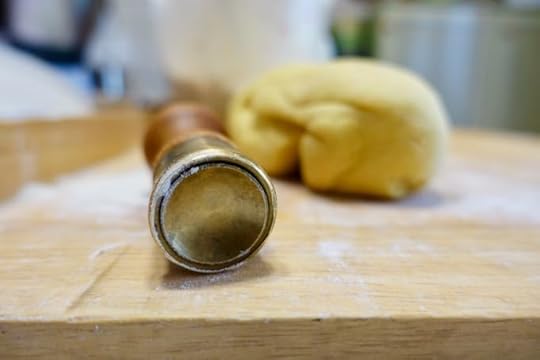
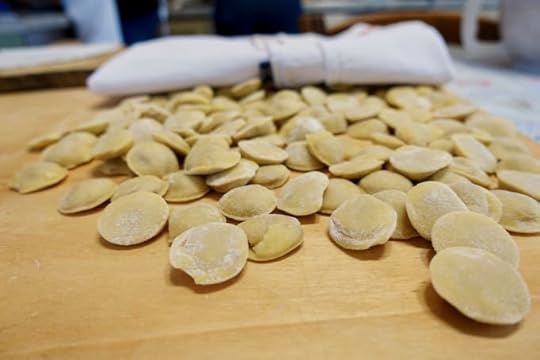
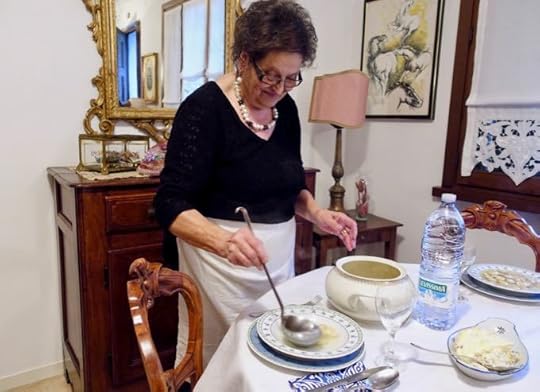
This blog post is an excerpt from my latest b0ok, Eating My Way Through Italy. You can find the full (and very long!) recipe for Silvana’s Anonlini in Brodo on page. 45.
There are most recipes and other information advice about following your appetite through Italy in Eating My Way Through Italy and Eating Rome.
For more on where to eat in Italy, please download my app EAT ITALY, available for iPhone and Android.
And if you’d like to join us around the table in Italy have a look at our Week in Italy Tours.
The post making anolini with silvana {video} appeared first on Elizabeth Minchilli.


November 29, 2018
Trattoria Cammillo {Florence}
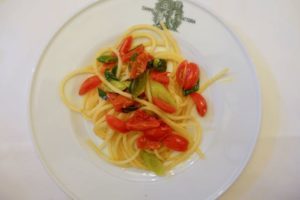
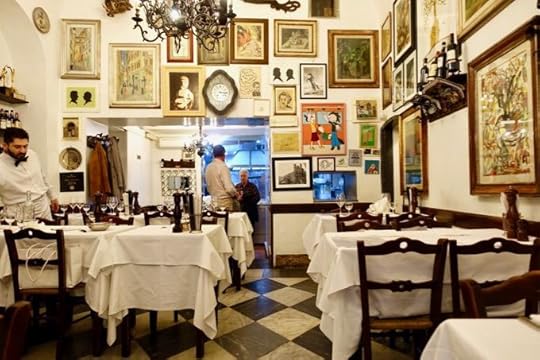
It always cracks me up that in cities like New York, Paris and London there are places that try so hard to mimic a true Italian restaurant. They often have good food, but kind of miss the point in re-creating the atmosphere. There is just no way that you can totally recreate patina. In certain restaurants and trattorie that have been there for decades, it’s not just the smoke and flavors from the kitchen that lends a place its sense of time, but the people who have passed through, and continue to work, dine and live in the places I love best.
In Rome you can follow Sophie on her instagram account (especially her stories) as she often hangs out for hours in the types of coffee bars where the main point is just sitting, chatting and watching life go by. You really can’t make this up.
Me? You’re more likely to find me traveling back in time in the glare of harsh lighting, crisp white table clothes and waiters who bring an art and flair to their trade. I’m talking about true, old fashioned ristorante and trattorie. And I’m willing to travel for a good one. A while ago I hopped on a train up to Florence just so I could finally make it to Cammillo. I’d been hearing about this bastion of Florentine dining forever from my friend Rolando. But since it was ‘his’ place, I didn’t want to go on my own. And somehow or other our paths never crossed long enough in Florence to make it there. Until now.
I was with Michael, the editor of my last two books Eating Rome and Eating My Way Through Italy) . After our all too quick train ride and walk across the Arno, we found Rolando already ensconced at ‘his’ spot. The large table which abuts the kitchen in the back is reserved for ‘family’ and you are more likely to see a grandmother here or else a child finishing their homework. But today Rolando, who has been coming here for decades, was taking his rightful place. And we felt lucky to join him.
The restaurant is called a ‘trattoria’ but feels more like a ‘ristorante.’ Freshly pressed linens cover the tables and equally freshly pressed linen cover the charming professional waiters. Framed artwork from patrons past cover the walls and black and white marble floors stretch back to the open kitchen.
All of the smells coming out of the kitchen were calling us, but Rolando took charge and ordered….what seemed like half of the very large menu. To stave off our urgent hunger from our trip up from Rome a plate full of prosciutto arrived within seconds. And then we quickly moved on to Rolando’s favorite antipasti. And since he knows me well, he was already defending his first choice. “Trust me,” he said before I could get a word in to express my doubts “This is the best foie gras you will ever have.” Because, well, foie gras in a Tuscan Trattoria? Yes, really. Made in house by the owner, Chiara, and served with home made dark bread it was ethereal. Much less pretension and more earthy than what you’d find at a fancier restaurant, I just about gobbled up the huge wedges all by myself.
Next came a lovely plate full of deep fried sage leaves stuffed with anchovies. We also had a mound full of julienned celeriac, served as a salad and topped with bottarga and hard boiled eggs. My kind of salad.
As massive grilled steaks were coming out of the kitchen past our table fast and furious, (they are cooked atop a wood fired grill in the back) we were just getting started on our primi. A half portion of perfectly cooked Spaghetti with fresh cherry tomatoes and spring garlic made its way to our table since it’s what Rolando usually orders (he’s a minimalist at heart) as well as the house specialty: Pappa al Pomodoro. This thick bread ‘soup’ was topped with shaved basil and doused in the fruity extra virgin olive oil.
Our main course finally got to the grilled meat we’d been salivating over as it passed by our table to other guests. Instead of the massive bistecca fiorentina (another speciality of the house) we decided we were craving rabbit (and as Michael said, you can never get it in New York) we ordered the de-boned grilled rabbit, rubbed with rosemary and just crispy enough around the edges. The rest of the table was overflowing with fritti: baby artichokes; zucchini blossoms stuffed with anchovies, crispy fried potatoes and light-as-air nuggets of fried veal brains.
We lingered long after the last guest had left, nibbling on our desserts and and slowly sipping coffee. We stayed so long that we even saw the waiters change out of their uniforms and go home until dinner service. But we had the family table, so no one was pushing us out the door. And this is the key to the kinds of places that draw me in. They are the kind of places you never want to leave.
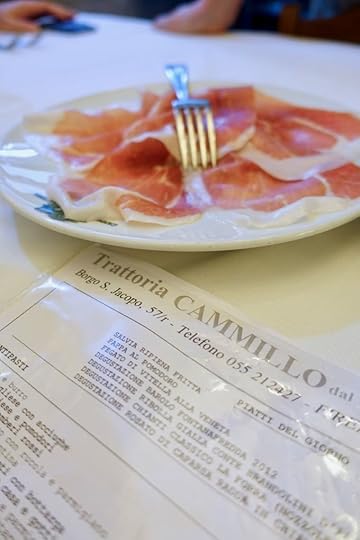
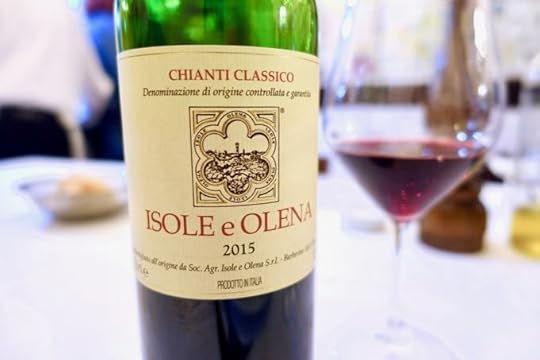
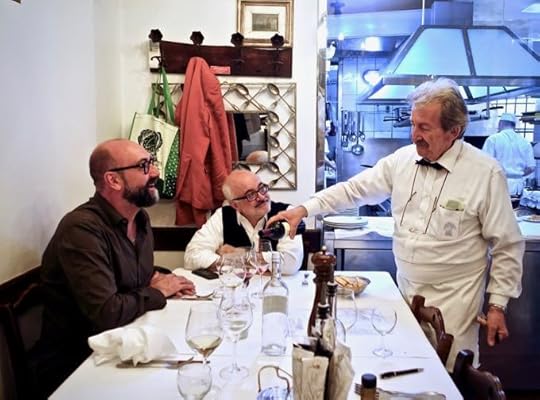
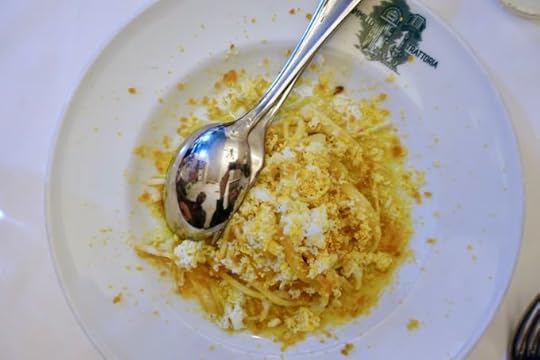
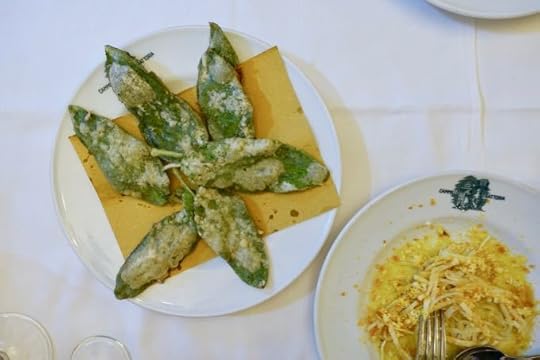
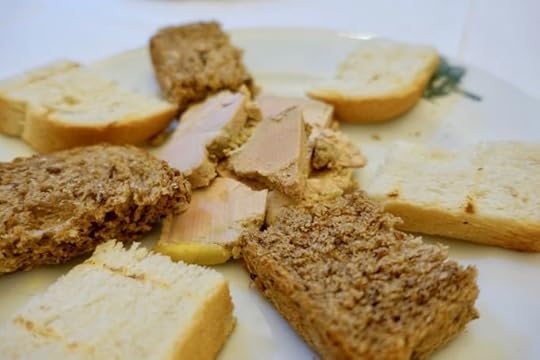
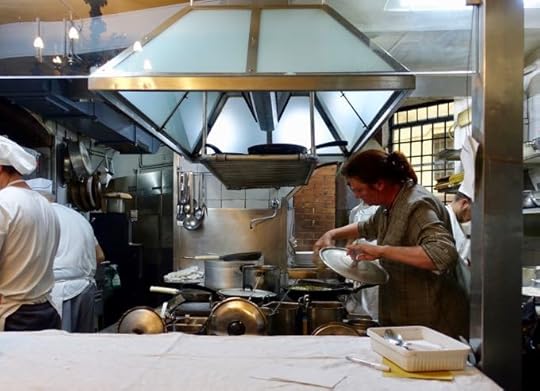
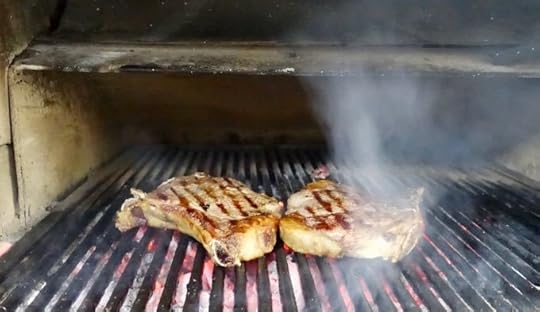
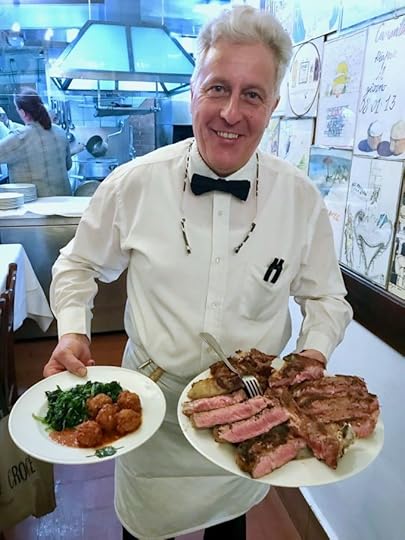
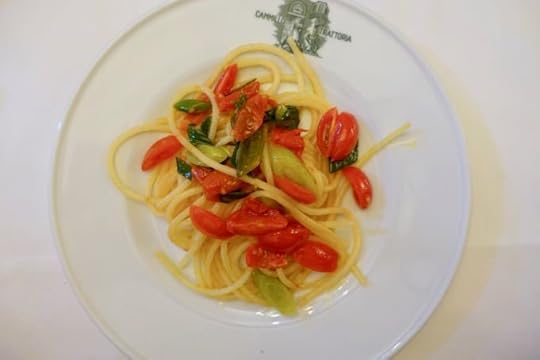
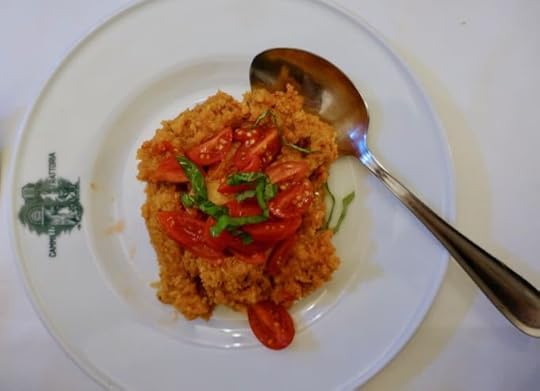
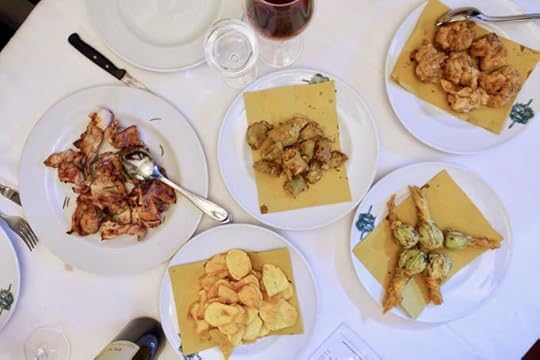
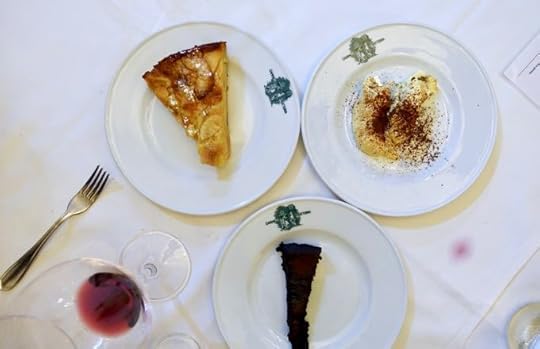
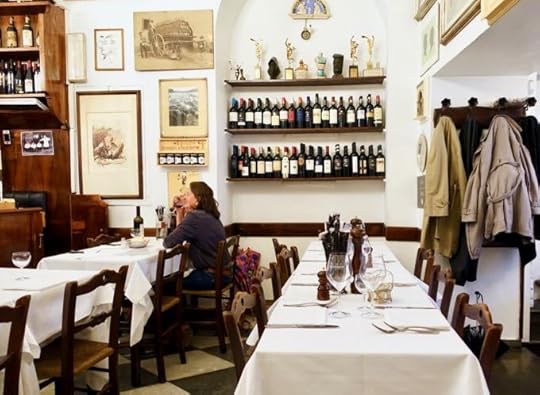
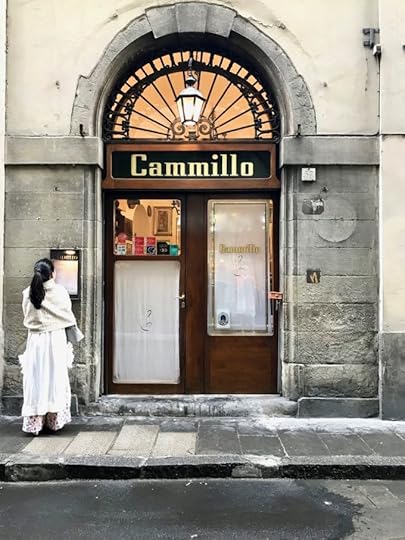
Trattoria Cammillo
Borgo San Jacopo 57R
Florence
tel: +39.055.212.427
Hours:
Thursday – Monday, 12-2:30; 19:30-22:30
Closed Tuesday and Wednesday
FYI: even though Cammillo is called a ‘trattoria’ it really is more of a ‘ristorante.’ And the service, and prices, reflect that. Also: they don’t have a website, you have to phone for a reservation and it books up way in advance.
For more on dining in Florence see my app, EAT ITALY available on iTunes and for Android as well as my book EATING MY WAY THROUGH ITALY.
For recipes and other information about Cammillo see Rolando’s book, Autentico.
And if you’d like to join me for a week full of long meals at some of my favorite places, have a look at the Week in Italy tours I’ve got planned.
The post Trattoria Cammillo {Florence} appeared first on Elizabeth Minchilli.


November 22, 2018
week in rome – black friday sale
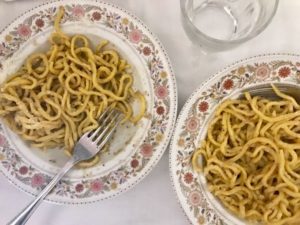
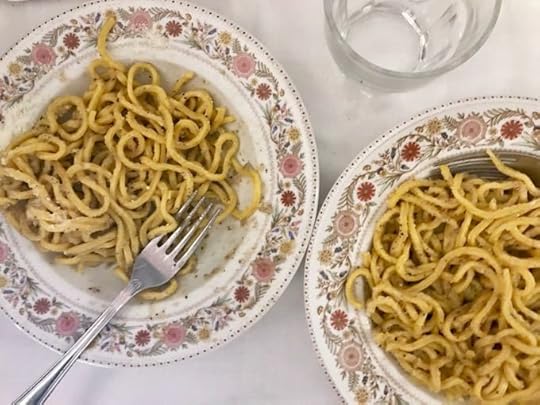
Would you like to join me in Rome next year? We could share a plate or two of cacio e pepe, visit the market and learn how to deep fry an artichoke. If you have been thinking about joining me on one of my Week in Italy Tours, here is a little bit of incentive: I’m having a Black Friday Sale.
For the next 48 hours (until midnight on Saturday November 24 EST) I am offering 15% discount on all of my Week in Rome Tours.
Week in Rome with Melissa Clark of the New York Times, March 3-9
Week in Rome with Elizabeth and Sophie, March 17 -23
Week in Rome with Elizabeth and Sophie, November 10-16
If you’re interested just send me an email, with the codeword: GOBBLEGOBBLE
I”ll send you the full description, with the normal price. Then, if you book it before midnight November 24, I”ll apply a 15% discount per person.
Also? Happy Thanksgiving!!!!
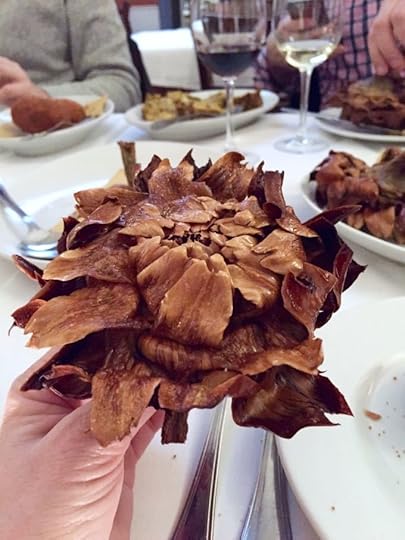
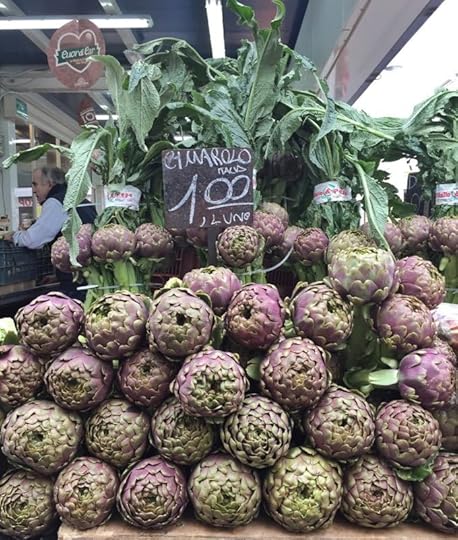
The post week in rome – black friday sale appeared first on Elizabeth Minchilli.


November 19, 2018
Thanksgiving Centerpiece + Dessert
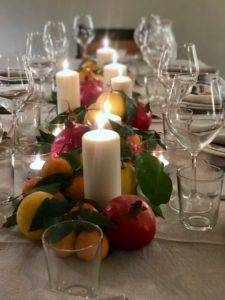
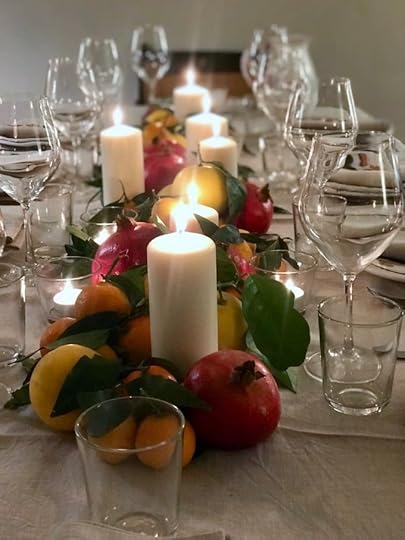
Are you rushing around trying to shop for last minute ingredients for Thanksgiving? This year we are invited to a friend’s house on Thursday and I’m in charge of a salad (I’m thinking this or this) and pumpkin pie. Even if Italians generally don’t ‘get’ pumpkin pie, I love it and even if I have to eat the whole thing myself, I’m making it. Also, is there anything better than cold pumpkin pie for breakfast on Friday???
During last week’s welcome dinner for our Week in Rome Tour there were two items on the menu that people kept telling me they were going to copy for their Thanksgiving meal. One wasn’t actually part of the menu, but was still edible: my centerpiece.
Whenever possible I try to make an edible centerpiece. This time of year it’s easy. For this one I just went to the Farmer’s market and loaded up on pomegranates, clementines and oranges. Bay leaves and candles did the rest.
Here is how I put it together:
4 pounds of oranges
4 pounds of clementines
8 pomegranates
2 packages of these candles from Ikea with these bases
8 votive candles with these holders also from Ikea
Bay leaves on the stem (or other types of shiny dark green leaves)
I like to use the packs of chunky candles from Ikea because they come in a pack of five and they are all different heights and widths. This makes things more varied and interesting.
Start out by placing the candles, on their glass stands, down the length of the table, being careful not to place them in a straight line. You want them to be laid out randomly, in no special order.
Next lay some of the leaves out (don’t over do it) between the candles, directly on the table cloth.
Now arrange the fruit: I usually start with the biggest (the pomegranates) then oranges, and finally the clementines. What you are aiming for is to place the fruit right up next to the candles, covering the glass bases. My oranges and clementines were so fresh they still had leaves attached, which was nice and added more green. If yours aren’t you can add a few more leaves in between the fruit.
Now place the votive candles here and there, tucking them in between the fruit along the edge.
The other thing that people asked me for? The recipe for Amanda’s delicious dessert: Mascarpone Persimmon Cream. There aren’t very many recipes that use super ripe persimmons, so this one’s a keeper. Amanda has made this dessert for us in the past, using different types of fruit (Strawberries and raspberries for instance) but this fall version with jelly like, bright orange persimmons was the best.
You might already have your dessert planned for Thanksgiving, so you can keep this one for later. But here’s hoping my centerpiece tips come in handy. Also? After Thursday you might want to eat only fruit for the next couple of days, so that’ll come in handy too.
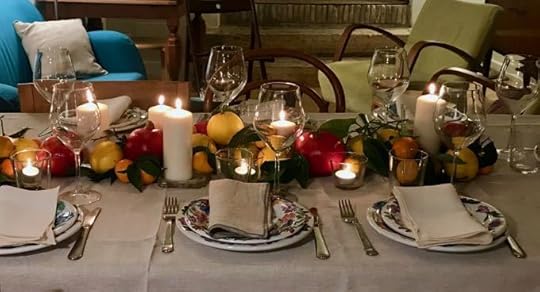
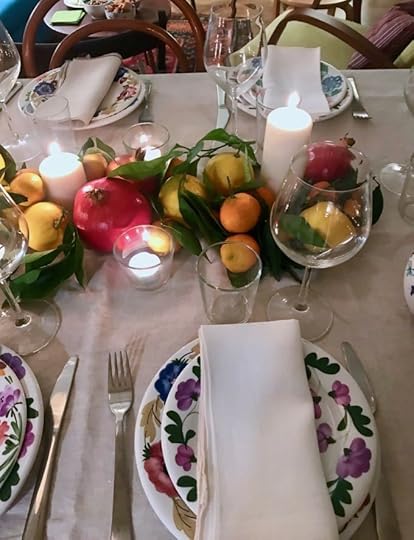
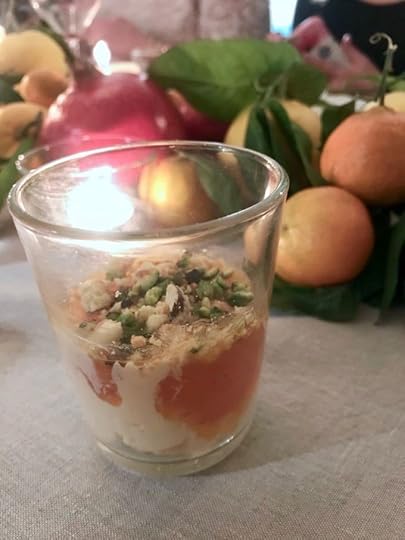
Mascarpone Cream & Persimmon
Yield 8
This recipe calls for super ripe Hachiya persimmons. This type cannot be eaten unless it is fully ripe and turns into a jelly like consistency. In fact, when perfectly ripe the jelly like pulp almost bursts through the skins.
Ingredients
3 large eggs, room temperature.
6 tbsp sugar
400 g mascarpone, kept cold in fridge until ready to use
6 super ripe persimmons.
4-5 biscotti, roughly crushed
1/3 cup chopped pistacchio nuts
Instructions
Scoop the pulp out of the persimmons, into a bowl. If there are big pieces of pulp, cut into smaller pieces with a fork or knife. The aim is to have a bowl full of bright orange jelly.
Separate the eggs, placing both in separate medium sized bowls.
Whisk egg whites until stiff.
Whisk the yolks and sugar together until pale and creamy
Whisk 1/4 cup of the cold mascarpone into the eggs and sugar mixture until smooth. Once it is mixed in, incorporate the rest of the mascarpone with a whisk.
Next fold in the egg whites, very gently, about 1/4 of the amount at a time. Be careful not to over work.
Keep in fridge until ready to serve
Divide into 8 individual glasses and top with 2 to 3 tablespoons of the persimmon pulp. Sprinkle with cookie crumbs and nuts and serve.
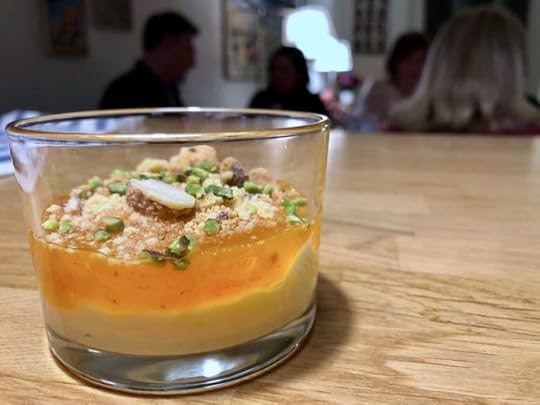
For more ideas about cooking up your own Italian feast at home, pre-order my newest book The Italian Table: Creating Festive Meals for Families and Friends (Rizzoli March 2019).
The post Thanksgiving Centerpiece + Dessert appeared first on Elizabeth Minchilli.


November 12, 2018
making pasta in gragnano
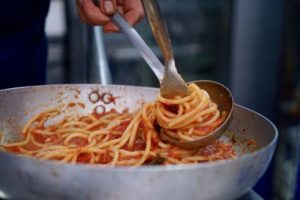
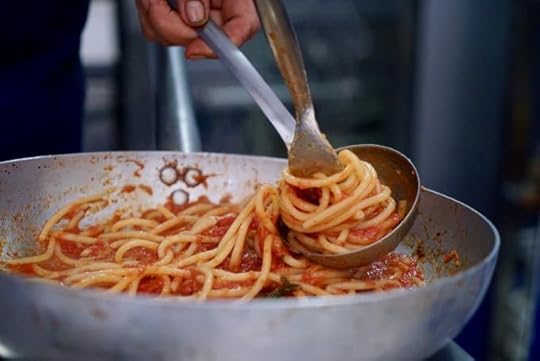
The one thing you’ve probably heard about pasta in Italy is that Marco Polo brought it here from China. This is almost certainly not true. Pasta has probably been going on in Italy for centuries, and may even date back as far as the Etruscans. But the pasta we are talking about, dried pasta, began its long road to our tables in the 18th century.
Dried pasta, unlike fresh pasta, is made from hard semolina, milled from durum wheat. Since this type of wheat grows in the south of Italy, in Sicily and in Campania, that is where much of the first pasta making industry developed. Particularly in the area in and around Naples, where the warm breezes off the hills assured that the pasta would dry, while the humid sea breezes insured it would not dry too fast, and crack. This reliance on natural setting meant that tourists to Naples commented on the streets filled with rows of pasta drying on the streets, terraces and even rooftops. Heaven, right?
But it was in nearby Gragnano that the first automation of pasta took hold. The small town was perfectly situated for drying pasta, with the dry Ponentino western winds coming off the hills, alternating with the warm and humid Vesuviano winds coming from the sea. And it was here that the extremely time consuming and strenuous process began to be automated. Dough made from durum wheat is extremely difficult to knead and it was here that the first automated kneading machines were made. It was also where the first presses that could extrude the unwieldy dough were put into action on a larger scale. And so it was from Gragnano that pasta began its way to becoming a more common food for masses, and not just a luxury for the upper class. Yet even though certain parts of the process were semi-automated, it was still being made a series of family run businesses that produced the pasta in small batches, in an artisanal manner.
And it was in Gragnano that some of the first drying rooms were invented. These rooms combined heat with wind, imitating the natural breezes so that pasta could be made all year round. The progress in Gragnano sought to preserve the traditional methods, especially maintaining the flavors that were the result of of the mountain breezes slowly drying local varieties of wheat over the course of several days.
As with all things, the process was adopted and industrialized and spread way beyond the pasta drying on the streets of Grangano. It was not long before big companies all over Italy began to produce pasta on a much larger scale, ramping up production by not only using inferior ingredients, but mostly by speeding up the drying process. While these advances has made Italian pasta one of the biggest exports around the world, it has also turned it into something that is a far cry from the traditionally made pasta still being made by some families in Gragnano and other parts of Italy.
While in Gragnano drying rooms were invented to mimic the natural breezes so that pasta could be made all year round,, big companies elsewhere in Italy left this far behind, speeding up the production process to make Italian pasta one of the biggest exports around the world.
Which is how we now arrive at the fact that not all dried pasta is created equal. And instead of talking about which is better, dried pasta or fresh pasta, I hope by now you realize that it’s more productive to be concerned telling the difference between great dried pasta and the more industrialized brands.
What’s the difference?
I recently got the chance to go behind the scenes, at two of the best pasta makers in Gragnano: Faella and Gentile (who are also two of my favorites). Both companies adhere to the older way of making pasta and their machinery produces relatively small quantities per batch. 1000 to 2000 kilos of semola di grano duro is turned into a bit more pasta.
There are several factors that differentiate artisanally dried pasta from the industrialized process. One, unsurprisingly is attention to ingredients (not only the flour, but also water) . Another is of course the process itself. Here are the major factors that differentiate artisanally made dried pasta from industrial brands:
Artisanally made pasta is extruded through bronze dies (vs. teflon) which gives it a rough texture that better absorbs the sauce.
Artisanally made pasta is dried at a lower temperature over a longer time which not only improves flavor but gives it a completely unique texture: firm and chewy, that is never found in industrially made pasta. In terms of timing we are talking about 20 minutes drying for industrially made pasta versus up to 48 hours drying time for artisanally made pasta.
Artisanally made pasta is made with just flour and water with no extra colorings, preservatives or additives. It is also usually made with high quality flour, as well as special attention to the water that is used
The importance of drying: This is probably the most important aspect of the process which differentiates the smaller, artisanal producers, from the industrial ones. Once the pasta is made, it is taken into drying rooms where over the course of up to 48 hours, wind and heat gently dry the pasta. This is not an automated process, since the timing and temperature can depend not only on the shape of the pasta, but the quality of the flour that day as well as the weather. It is up to the master Pastaio to decide exactly how to alternate air and heat, and it is he who decides when the pasta is ready to be packaged.
And if you have sometimes wondered why it is so difficult to cook pasta to that perfect al dente point, it is because the high heat used to dry industrial pasta practically pre-cooks the pasta, effecting the final texture.
Like many artisanally made food products in Italy, Pasta di Gragnano is recognized by an IGP label. The Consortium that monitors this process is the Consortium Gragnano Citta della Pasta. But like all such regulators, not everyone agreed with the rules. It’s not that the rules were too strict, but that they weren’t strict enough. Specifically regarding the drying process, the Consortium states that the pasta much be dried from 6 to 40 hours, at from 40 to 80 degrees Celsius. That is a huge amount of leeway and in fact allows for the making of quickly dried pasta at high temperatures. All this to say that even if a pasta is from Gragnano, it doesn’t necessarily mean it is the best.
Try this at home:
If you don’t quite believe me so far, in terms of the difference in taste and texture, then I have some homework for you. I’d like to you to try one of the high end brands, next to the one you usually buy at the supermarket. I realize this involves spending money. The high end pastas I’m talking about, by companies like Rustichella, Gentile, Faella , Martelli and Benedetto Cavalieri cost anywhere from 6 to 12 dollars for a pound, versus about $1.50 for a supermarket brand.. Because the difference in taste, in texture and in the finished dish is hard to describe here, you’re just going to have to experiment yourself. And if you have time, and energy, try making two batches of pasta, one of your regular brand, and one of the better ones. Then dress them with a simple coating of olive oil. Let me know what you think. I think that people have gotten so used to the idea of cheap pasta, that they don’t realize that there is alternative that tastes completely different. And better
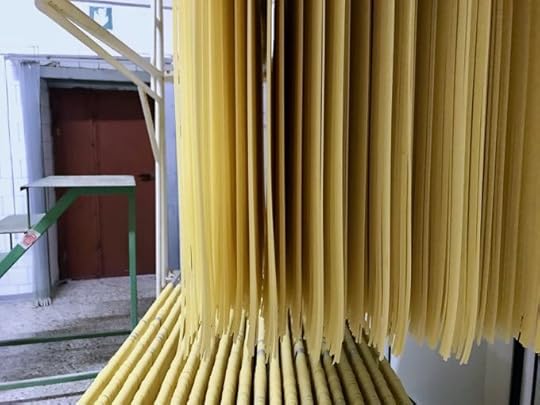
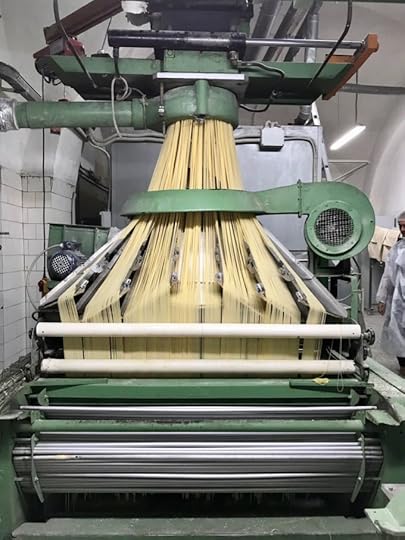
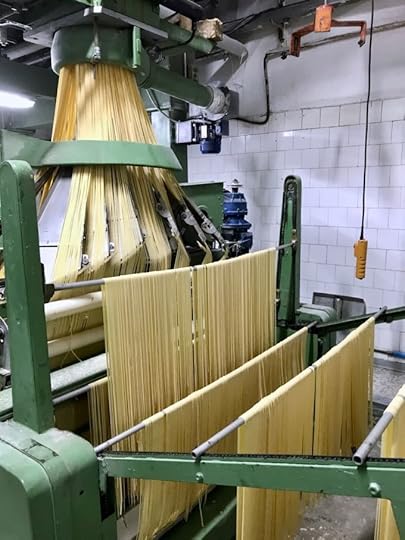
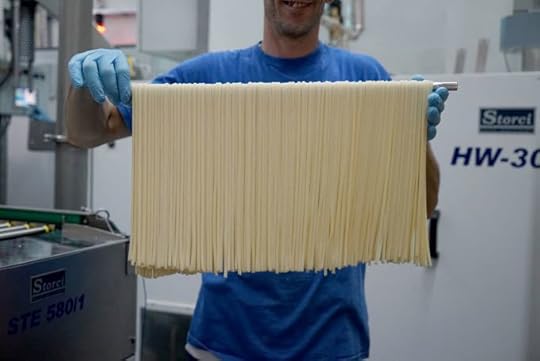
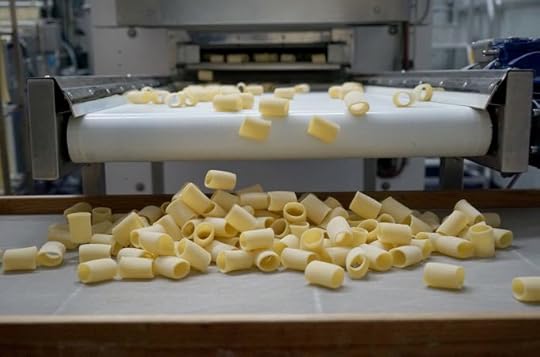
Spaghettone al Pomodoro
Yield 4-5
While I was in Gragnano I had the great luck to not only visit the Pasta Gentile factory but to hang out in the kitchen with Mamma Maria, the matriarch of the Zampino family that owns the company. She prepared various pastas pastas for me to try. Naturally the sauces were simple, to bring out the pure taste of the pasta. My favorite was the Spaghettone she made with a simple tomato sauce. Spaghettone are Gentile’s signature pasta, and is a toothsome thick strand of thick spaghetti measuring 2.7 millimeters in diameter . Since there are so few ingredients, the specific choice really does make a huge difference. For this sauce Mamma Maria, like most Italians, use canned pelati San Marzano tomatoes. She actually follows these tomatoes from seed to can, but if you can’t manage that see the resources below for the real thing.
Ingredients
1 pound/ 1/2 kilo Spaghettoni Gentile
70 gr EVO
1 smashed garlic clove
8 basil leaves
750 grams Canned San Marzano Tomatoes
1/2 half teaspoon salt
Instructions
Bring a large pot of salted water to boil. Add the pasta. While pasta cooks (if you are using spaghettone then it will take a while) make the sauce.
Pour the olive oil in a saute pan big enough to hold all of the drained, cooked pasta. Add the smashed garlic clove and the basil. After one minute add the canned tomatoes with their juice and salt. Turn heat to high and cooked quickly, using a wooden spoon to break up the tomatoes.
Taste and adjust for seasoning.
Drain the pasta when it is just short of al dente, retaining one cup of cooking water. Put the drained pasta into the pan with the sauce, and stir over medium heat to finish cooking, till al dente. If the sauce seems too dry, add a bit of reserved cooking water.
Serve garnished with fresh basil leaves and grated parmigiano reggiano on the side.
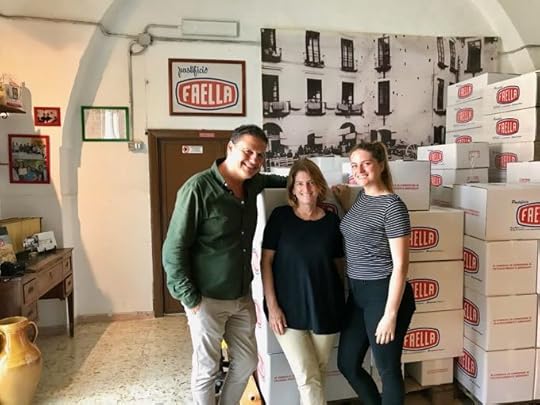
Sophie and I in our happy place: photographed with all the Faella pasta in the world. Along with Sergio Cinque, the owner.
This blog post is an excerpt from my book Eating My Way Through Italy.
More pasta recipes and other information about following your stomach through Italy is in my most recent book Eating My Way Through Italy.
For more on where to eat in Italy, please download my app Eat Italy, available for both iPhoneand Android.
And if you’d like to host your own Italian meal at home, make sure you buy my next book, The Italian Table: Creating Festive Meals for Family and Friends (March 2019), available for preorder.
The post making pasta in gragnano appeared first on Elizabeth Minchilli.





